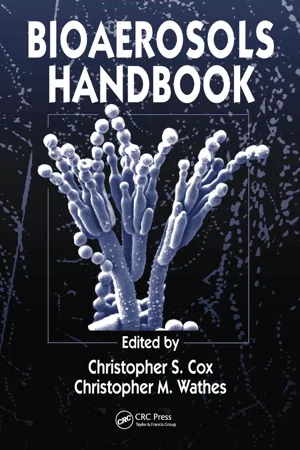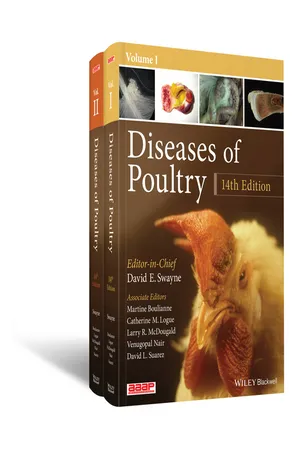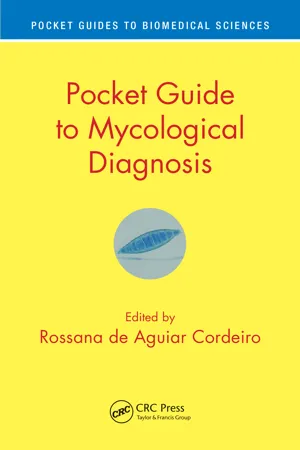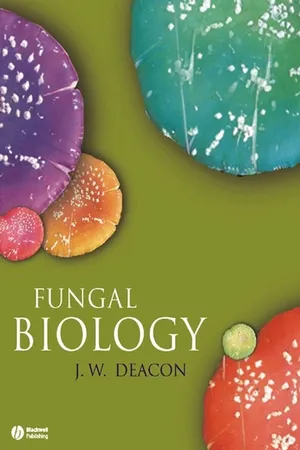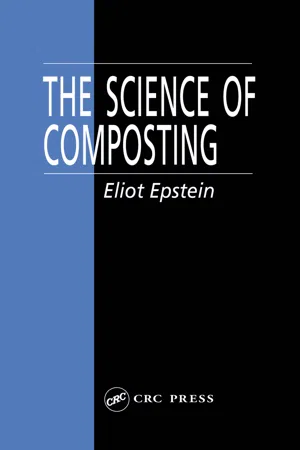Aspergillus
Aspergillus is a genus of mold fungi commonly found in the environment, including soil, decaying vegetation, and indoor environments. Some species of Aspergillus can cause respiratory infections in humans, particularly in individuals with weakened immune systems. Additionally, certain species of Aspergillus are used in the production of various industrial enzymes and organic acids.
7 Key excerpts on "Aspergillus"
- eBook - ePub
- Christopher S. Cox, Christopher M. Wathes, Christopher S. Cox, Christopher M. Wathes(Authors)
- 2020(Publication Date)
- CRC Press(Publisher)
...Incidence of invasive aspergillosis and infection by other opportunistic genera in man has increased in recent years with advances in transplant surgery and the accompanying use of immunosuppressive drugs, and also with the rise of immune-deficiency diseases. In microscopic examinations complete conidial heads may be seen. The aspergilli grow readily on standard fungal media but it must be borne in mind that they are very common contaminants on culture plates and also are routinely present in the upper respiratory tract. Atopic individuals may develop allergic aspergillosis diagnosed by an immediate response to a skin test with an extract of the fungus, sometimes followed by a later delayed response. Fungus balls or mycetomas may form in lung cavities, sometimes in post-operative, healed lesions. Aspergillomas are the most common type of mycetoma, with Aspergillus fumigatus the most frequent species. They do not usually invade healthy tissues and may resolve spontaneously. TOXICITY Many fungi produce secondary metabolites in nature or in artificial culture or both. Many of these are toxic to particular organisms, including farm animals and man, and thus have acquired economic and social importance. 98, 99 Ingestion of molded foodstuffs is the usual means of conveying the toxin into the body, but there is increasing evidence that inhaled aerosols of fragments of mycelium, spores and molded substrate may be sources of mycotoxins of veterinary or medical significance. Both spores and dust pose a health hazard to handlers of grain, for both may contain mycotoxins. With different fungi, the relative distribution of mycotoxin between the mycelium-substrate (MS) matrix and spores differs. Among the toxins of certain Aspergillus and Penicillium species, aflatoxin B1, norsolorinic acid and secalonic acid D predominate in the MS-matrix, whereas aurasperone C and fumigaclavine C predominate in the spores...
- eBook - ePub
- Mahmoud Ghannoum, Matthew Parsek, Marvin Whiteley, Pranab K. Mukherjee, Mahmoud Ghannoum, Matthew Parsek, Marvin Whiteley, Pranab K. Mukherjee(Authors)
- 2015(Publication Date)
- ASM Press(Publisher)
...8 Aspergillus Biofilm In Vitro and In Vivo ANNE BEAUVAIS 1 and JEAN-PAUL LATGÉ 1 INTRODUCTION Aspergillus fumigatus is the most important airborne fungal pathogen in the world. The conidia are inhaled by the entire population and cause a wide range of diseases from simple rhinitis to fatal invasive aspergillosis (IA) in immunocompromised patients (1). The number of A. fumigatus chronic infections is constantly increasing in immunocompetent patients suffering from respiratory problems such as chronic obstructive pulmonary disease (22%), asthma (1 to 5%), and cystic fibrosis (5 to 10%), along with 15% allergic bronchopulmonary aspergillosis. Aspergillus is also the cause of lung and sinus aspergilloma and serious fungal keratitis infections (2, 3). Until a few years ago, most studies undertaken to understand Aspergillus physiology and virulence were performed with the fungus growing in shaken liquid flasks or fermentors. Such an experimental set-up was the most appropriate to obtain an important biomass to undertake biochemical studies and to purify secreted molecules or antigens from the culture filtrates or mycelial extracts. In contrast, in all Aspergillus infections, as well as in nature on a solid substratum, A. fumigatus grows as a colony characterized by multicellular and multilayered hyphae which are embedded in an extracellular matrix (ECM) (4, 5). This type of growth is consistent in general with the definition of a biofilm: a structural microbial community of cells enclosed in an ECM. However, A. fumigatus biofilms are very different from yeast biofilms (6). In this regard, biofilms formed by filamentous fungi contain septate hyphae that are structurally attached to form microbial colonies. Thus, a better understanding of the infectious process should be based on the study of the biofilm colonies rather than on cells grown in planktonic form in shaken flasks. This article will summarize our present knowledge of biofilms formed by A...
- eBook - ePub
- (Author)
- 2019(Publication Date)
- Wiley-Blackwell(Publisher)
...According to their immunological status, inhalation of Aspergillus spores may cause multiple diseases in humans including invasive pulmonary aspergillosis in immunocompromised patients but also different forms of hypersensitivity diseases such as allergic asthma or pneumonitis (93). Therefore, care should be taken to avoid heavy environmental exposure to spores. Protective face masks should preferably be used when removing moldy hay, feed, and litter from poultry barns and when performing necropsies on heavily affected animals (15). Sporulating cultures should be handled with care in the laboratory. History Molds, likely belonging to the genus Aspergillus, were described in a Greater Scaup (Aythya marila) and in a captive flamingo in the early 1800s. The first description of Aspergillus in a lesion was in 1842 when Rayer and Montagne identified A. candidus from the air sac of a bullfinch. In 1863 Fresenius introduced the term aspergillosis when investigating the infection of the air sacs of a great bustard (Otis tarda) by the mold he described as Aspergillus fumigatus. Since then, these fungal agents have been involved in sporadic cases but also in die‐offs either in free‐ranging or captive birds and have provoked significant economic losses in the poultry industry (3, 15, 25). Etiology Classification The genus Aspergillus includes approximately 250 species (2) but only a few well‐known species are considered to be important opportunistic pathogens in vertebrates and invertebrates (93). A. fumigatus is the principal agent causing aspergillosis in poultry because the spores are very small and easily inhaled. Isolation of A. flavus is less common but not rare in heavily contaminated environments with high spore load (5, 16, 53). Other species like A. niger, A. nidulans, A. terreus, and A. amstelodami (3, 25) may also be isolated from avian cases of aspergillosis when the environment is heavily contaminated with fungi...
- eBook - ePub
- Rossana de Aguiar Cordeiro(Author)
- 2019(Publication Date)
- CRC Press(Publisher)
...9 Aspergillus spp. Reginaldo Gonçalves de Lima-Neto, Patrice Le Pape, and Rejane Pereira Neves Contents 9.1 Introduction 9.2 Types and symptoms of aspergillosis 9.2.1 Invasive aspergillosis 9.2.2 Aspergilloma 9.2.3 Chronic fibrosing pulmonary aspergillosis 9.2.4 Allergic aspergillosis 9.2.5 Cutaneous aspergillosis 9.3 Aspergillosis risk factors and prevention 9.4 Approach to diagnosis 9.5 Resistance in Aspergillus spp. References 9.1 Introduction The disease “aspergillosis” refers to allergy, respiratory tract invasion, cutaneous infection, or extrapulmonary dissemination caused by species of Aspergillus, mainly A. fumigatus, A. flavus, A. niger, and A. terreus. Aspergillus species are cosmopolitan and inhalation of spores is common. However, tissue invasion is not frequent, but may happen in the case of hosts which are immunosuppressed due to therapy for hematologic malignancies, receipt of hematopoietic cells, or solid organ transplantation (Shannon et al., 2010). Aspergillus filamentous fungi are very common in all environments, so it is impossible to completely avoid breathing in some conidia. In people with healthy immune systems, this does not lead to infection. However, in people with debilitated immune systems, inhaling Aspergillus spores can cause lung or sinus infection, which can spread to other parts of the body. There are approximately 180 species of Aspergillus, but fewer than 40 of them are known to cause infections in humans (Barnes & Marr, 2006). Indeed, Aspergillus mold is inescapable. Outdoors, it is found in decaying leaves and on plants, trees, and grain crops. Inside, the conidia thrive in air conditioners, heating ducts, and some foods. Everyday exposure to Aspergillus is rarely a problem for people with healthy immune systems because the defensive cells surround and destroy the spores. But a weakened immune system allows Aspergillus to take hold, invading the lungs, and, in the most serious cases, other parts of the body...
- eBook - ePub
- J. W. Deacon(Author)
- 2013(Publication Date)
- Wiley-Blackwell(Publisher)
...A single ascospore can give rise a colony that will produce the sexual stage. Ecology and significance Because the Ascomycota is a very large and important phylum, many aspects of its biology are covered in the later chapters of this book. The group as a whole includes many economically important plant pathogens, such as the powdery mildew fungi of many crop plants (Chapter 14), the vascular wilt fungi (Chapter 14), Ophiostoma ulmi and O. novo-ulmi, which cause the devastating Dutch elm disease that swept repeatedly across Europe and the USA in the last century (Chapter 10), the equally devastating chestnut blight disease in the USA, caused by Cryphonectria parasitica (Chapter 9) and several toxigenic fungi, such as Claviceps purpurea (ergot of cereals; Chapter 7). The Ascomycota also includes several pathogens of humans, domesticated animals and livestock. For example, the ubiquitous dermatophytic (ringworm) fungi are estimated to infect about half of the total human population, especially in the tropics and subtropics, but also in developed countries, where infections such as “athlete’s foot” and “nail fungus” are common. The ascomycetous yeast, Candida albicans, is a common commensal organism in the gut and on other mucosal membranes of humans, causing irritation to people who wear dentures and to women during menstruation or pregnancy. And, some ascomycetous fungi (Blastomyces dermatitidis, Histoplasma capsulatum) can cause life-threatening diseases of humans whose immune system is deficient or impaired. The “Moulds of Man” are covered in Chapter 16. In a different context, some of the Ascomycota form mycorrhizal associations with forest trees (e.g. Tuber spp – the truffles) and an estimated 96% of the 13,500 known species of lichens have Ascomycota as the fungal partner. Very few of these lichenized fungi grow in a free-living state...
- eBook - ePub
- Eliot Epstein(Author)
- 2017(Publication Date)
- CRC Press(Publisher)
...(Courtesy of Dr. Pat Millner, USDA, Beltsville, MD.) Figure 9.3 Aspergillus fumigatus colony. (Courtesy of Dr. Pat Millner, USDA, Beltsville, MD.) Figure 9.4 (a)A fumigatus hypha in aspergilloma. (Courtesy of Dr. Jonathan Epstein, M.D., Johns Hopkins Medical Center, Baltimore, MD.) (b) Low power of MS stain of A. fumigatus. (Courtesy of Dr. Jonathan Epstein, M.D., Johns Hopkins Medical Center, Baltimore, MD.) Rippon (1974) indicated that three factors are involved in disseminating aspergillosis: (I) lowering ofresistance due to drugs or a debilitating disease, (2) an opportunity for invasion, and (3) disruption of the normal flora and inflammatory response by antibiotics or steroids. Slavin and Winzenburger (1977) described five types of lung disease caused by Aspergillus. Invasive or septicemic aspergillosis in which invasion of the bronchial wall produces a definite bronchitis often with systemic spread. Saprophytic or aspergilloma in which the organism colonizes preexisting anatomic abnormalities such as congenital cysts or bronchiec-tatic cavities. Extrinsic allergic alveolitis in which the organism produces a precipitating antibody and cell-mediated immunity response resulting in a hypersensitivity pneumonitis. Bronchial asthma in which the mold produces an IgE-mediated bron-chospasm. Allergic bronchopulmonary aspergillosis (ABPA), a condition first described in 1952 and characterized by pulmonary infiltrates and peripheral blood and sputum eosinophilia. According to Lacey (1991), allergic rhinitis and asthma occur in subjects who are predisposed to allergy and are readily sensitized by normal, everyday exposure to airborne allergens...
- eBook - ePub
Mycotoxins in Food and Beverages
Innovations and Advances Part I
- Didier Montet, Catherine Brabet, Ramesh C. Ray, Sabine Galindo, Didier Montet, Catherine Brabet, Ramesh C. Ray, Sabine Galindo(Authors)
- 2021(Publication Date)
- CRC Press(Publisher)
...Postepy higieny i medycyny doswiadczalnej 71: 315–327. DOI: 10.5604/01.3001.0010.3816. Kumar, P., Mahato, D.K., Kamle, M., Mohanta, T.K. and Kang, S.G. 2017. Aflatoxins: A global concern for food safety, human health and their management. Frontiers in Microbiology 7: 2170. DOI: 10.3389/fmicb.2016.02170. Kumeda, Y., Asao, T., Takahashi, H. and Ichinoe, M. 2003. High prevalence of B and G aflatoxin-producing fungi in sugarcane field soil in Japan: Heteroduplex panel analysis identifies a new genotype within Aspergillus section Flavi and Aspergillus nomius FEMS Microbiology Ecology 45: 229–238 DOI: 10.1016/S0168-6496(03)00154-5. Kurtzman, C.P., Horn, B.W. and Hesseltine, C.W. 1987. Aspergillus nomius, a new aflatoxin-producing species related to Aspergillus flavus and Aspergillus tamarii. Antonie van Leeuwenhoek 53(3): 147–158. DOI: 10.1007/BF00393843. Lewis, L., Onsongo, M., Njapau, H., Schurz-Rogers, H., Luber, G., Kieszak, S. et al. and the Kenya Aflatoxicosis Investigation Group. 2005. Aflatoxin contamination of commercial maize products during an outbreak of acute aflatoxicosis in eastern and central Kenya. Environmental Health Perspectives 113: 1763–1767. DOI: 10.1289/ehp.7998. Magan, N., Medina, A. and Aldred, D. 2011. Possible climate-change effects on mycotoxin contamination of food crops pre- and post-harvest: Mycotoxins and climate change. Plant Pathology 60(1): 150–163. DOI: 10.1111/j.1365-3059.2010.02412.x. Makhlouf, J., Carvajal-Campos, A., Querin, A., Tadrist, S., Puel, O., Lorber S. et al. 2019. Morphologic, molecular and metabolic characterization of Aspergillus section Flavi in spices marketed in Lebanon. Scientific Reports 9(1): 5263. DOI: 10.1038/s41598-019-41704-1. Mamo, F.T., Shang, B., Selvaraj, J.N., Wang, Y. and Liu, Y. 2018. Isolation and characterization of Aspergillus flavus strains in China. Journal of Microbiology 56(2): 119–127. DOI: 10.1007/s12275-018-7144-1. Manizan, A.L. 2019...
